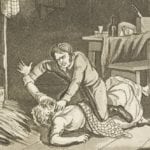 Creepy
Creepy  Creepy
Creepy  Technology
Technology 10 Scientific Breakthroughs of 2025 That’ll Change Everything
 Our World
Our World 10 Ways Icelandic Culture Makes Other Countries Look Boring
 Misconceptions
Misconceptions 10 Common Misconceptions About the Victorian Era
 Mysteries
Mysteries 10 Strange Unexplained Mysteries of 2025
 Miscellaneous
Miscellaneous 10 of History’s Most Bell-Ringing Finishing Moves
 History
History 10 Great Escapes That Ended Right Back in Captivity
 Weird Stuff
Weird Stuff 10 Fascinating Things You Might Not Know About Spiders
 Food
Food 10 Everyday Foods You Didn’t Know Were Invented by the U.S. Military
 History
History 10 Odd Things Colonial Americans Kept at Home
 Creepy
Creepy 10 More Representations of Death from Myth, Legend, and Folktale
 Technology
Technology 10 Scientific Breakthroughs of 2025 That’ll Change Everything
 Our World
Our World 10 Ways Icelandic Culture Makes Other Countries Look Boring
Who's Behind Listverse?

Jamie Frater
Head Editor
Jamie founded Listverse due to an insatiable desire to share fascinating, obscure, and bizarre facts. He has been a guest speaker on numerous national radio and television stations and is a five time published author.
More About Us Misconceptions
Misconceptions 10 Common Misconceptions About the Victorian Era
 Mysteries
Mysteries 10 Strange Unexplained Mysteries of 2025
 Miscellaneous
Miscellaneous 10 of History’s Most Bell-Ringing Finishing Moves
 History
History 10 Great Escapes That Ended Right Back in Captivity
 Weird Stuff
Weird Stuff 10 Fascinating Things You Might Not Know About Spiders
 Food
Food 10 Everyday Foods You Didn’t Know Were Invented by the U.S. Military
 History
History 10 Odd Things Colonial Americans Kept at Home
10 More Evil Serial Killers That Are Still On The Run
We’ve written about a lot of serial killers at Listverse, because people like reading about them as much as the world likes to unleash them on us. Sadly, not all serial killers are caught, and we’ve listed some of those cases before. However, in case you were finding it too easy to sleep at night, here are 10 more brutal killers that, for all we know, are still out there.
10The Bowraville Killer

In 1991, a 16-year-old Aboriginal girl named Colleen Walker-Craig disappeared from her hometown of Bowraville, New South Wales. Three weeks later, a four-year-old named Evelyn Greenup vanished. A short time after that, a 16-year-old boy named Clinton Speedy became the third youngster to go missing.
Two weeks later, Clinton’s body was found in the hills that surrounded the town, shortly followed by Evelyn’s. Both had been killed by a blow to the head. Colleen’s body has never been found, although her clothes were discovered in a nearby river. What had been a frantic missing persons hunt became the quest for a serial killer.
In the 23 years since the deaths, only one major suspect has emerged—Jay Hart, a white laborer in his mid-twenties with a record of supplying drugs to the Aboriginal community. Witness reports claimed he also had a history of violence against women and a reputation for making sexual advances toward teenage girls, including Colleen.
In 1994, Hart was acquitted of the murder of Clinton Speedy. Prosecutors weren’t able to bring a case against him for the death of Evelyn Greenup until 2005, when he was once again found not guilty. Due to the lack of a body, no one has ever been tried for Colleen’s disappearance and presumed death. Hart moved away, changed his name, and set up a new life. A newspaper tracked him down in 2013, discovering he was employed working with troubled Aboriginal youths. In November 2013, the state’s attorney general announced a new judicial inquiry into the deaths.
9The Vending Machine Murders

At least 10 people were killed by the strange series of murders that shocked Japan in 1985. The killer poisoned dozens of bottles of juice and soda and hid them in vending machines throughout the country. The poison used was a herbicide named paraquat, which has also been frequently used as a method of suicide.
The bottles would usually be placed in the machine’s dispensing chute. When someone bought a drink they would end up with two bottles and accept the unexpected drink as a stroke of luck. After a few mouthfuls, nausea would set in. After a day or two, breathing would stop. On top of the 10 dead, at least 35 people were poisoned but survived. Media coverage of the crimes was accused of inspiring copycats, one of whom left poisoned milk in schools.
More than a million warning stickers were placed on vending machines around the country. However, the case remains unsolved. In 1998, another series of random poisonings shook the country. Curry laced with arsenic was discovered at a community food festival, killing four people and causing 60 more to fall ill. Vending machines once again became a target, with poisoned tea sending dozens to the hospital. Copycats were once again blamed for many of the poisonings, suggesting Japan’s problem goes much deeper than a single rogue maniac.
8Daytona Beach Killer

Between late 2005 and early 2008, four women were found dead in Florida’s Daytona Beach. In each case, the women had been shot, execution-style, through the head. No attempt had been made to hide the bodies. Matching DNA was found at three of the murder scenes.
The first victim found was Laquetta Gunther, a 45-year-old believed to work as a prostitute, who was found in an alley on Boxing Day 2005. Less than a month later, 34-year-old Julie Green was found in a ditch at a construction site. The third victim was Iwana Patton, 35, who was discovered on a dirt road on February 24. The killer didn’t strike again until January 2008, when 30-year-old Charlene Gage became the last victim of the Daytona Beach Killer.
There were multiple theories as to the killer’s identity. The type of firearm used was the same sort issued to law enforcement in the area, and several active and retired police officers were questioned. Others thought it could be a long-haul trucker who happened to pass through the area. This particular theory was supported by a woman named Nelita Ramos, who claimed that a trucker had kidnapped her at gunpoint in January 2006. When the man led her to an alley, she begged for her life and was miraculously let go.
The FBI have linked the killings to 24 other murders that have occurred beside highways in Florida. While the murders aren’t all necessarily believed to have been carried out by the same person, they are all suspected to be the work of long-haul truckers.
7The Flat-Tire Killer

The Flat-Tire Murderer sounds like an urban legend, but his crimes were terrifyingly real. In 1975, five women and girls were killed by a man in Dade County, Florida. The killer would deflate his victim’s tires while they were gone and then conveniently offer assistance, gaining his victims’ trust, before kidnapping them. One of the women, a 23-year-old named Barbara Stephens, was kidnapped from the mall and stabbed to death using this trick.
The killer was also associated with the murder of two 14-year-old schoolgirls. The police at the time reported similarities to murders elsewhere in the country and detectives in Florida, Utah, and California developed a theory that one man may have been responsible for 33 deaths throughout the US. Some of the murders were eventually confessed to by Ted Bundy, but the deaths in Florida remain unsolved.
6The B1 Butcher

While most serial killers leave bodies, Namibia’s B1 Butcher earned his name because he only leaves body parts. In November 2007, a torso was found in a garbage can beside the country’s central B1 road. Three days later, two thighs were found in separate places along the road. It was only after a month that the victim was identified as Sanna Helena Garoes. Her head, feet, and the remainder of her legs were later discovered by farm workers. It was the latest in a series of killings attributed to the Butcher, who began his reign of terror in 2005.
The first victim was Melanie Janse, whose mutilated body was found in August 2005. The next body, found in September, was 21-year-old Juanita Mabula, who had been decapitated. After the funeral, Juanita’s aunt said, “the most difficult thing for us was to bury our sister without her head.” The head in question was found a few weeks later. On December 28, 2005, the youngest victim was found—18-year-old Viola Swartbooi. Her body was too badly decomposed to establish the cause of death.
In October 2007, the Namibian police teamed up with specialists from national intelligence and brought in serial killer experts from neighboring South Africa. Just a month later, a head and a set of forearms were found in a plastic bag near a hospital. While there may be other victims, none have been found, and the butcher himself remains at large.
5The Hwaseong Murders

The most notorious serial killer in the history of South Korea murdered 10 women over a period of five years, starting in 1986. His victims were all strangled to death with their own clothes. Their ages ranged from 13 to 71, and many were raped. His final victim was a 69-year-old woman found strangled with her own pantyhose on April 3, 1991.
The hunt for the killer became a national issue but failed to achieve a significant breakthrough. The only description the police had to work with came from the killer’s would-be fourth victim, who was raped but survived. She described the killer as a slim man in his early 20s. There was also some DNA recovered, but it didn’t match any of the 570 samples analyzed from suspects.
The statute of limitations meant that it would be impossible to try anyone for the crimes after 2006. That law has since been altered, in large part due to the Hwaseong case, in order to extend the length of time after which a killer can be prosecuted.
4The New Bedford Highway Killer

In 1988, a serial killer murdered 11 women in New Bedford, Massachusetts, dumping the bodies at the side of the road just outside the city. The killer, who targeted sex workers and drug addicts, carried out the murders between April and September of that year. However, the police didn’t realize that a serial killer was active until November, when the third body was found. By that point, the killer had stopped and possibly moved on.
The police pursued two men as suspects. One was Tony DeGrazia, who had a history of sexually assaulting prostitutes. No evidence was found to link him to the deaths, and he committed suicide in 1990. In August of that year, an attorney named Kenneth Ponte was indicted for the murder of Rochelle Clifford, but the case was dropped due to lack of evidence. In 2007, police dug up an area outside of one of Ponte’s old houses in an attempt to crack the increasingly cold case. Ponte died in 2010.
Another theory is that the killer may be the Lisbon Ripper, the unidentified perpetrator of a series of murders in Portugal in the 1990s. New Bedford has a large Portuguese community and if the killer left the country to continue his crimes, it might explain why he operated over such a short space of time—and has been so hard to track down.
3The Edgecombe County Serial Killer

North Carolina’s Edgecombe County has been the hunting ground of at least one serial killer, who killed nine women and one man between 2005 and 2010. A man named Antwan Maurice Pittman has since been convicted of one of the murders, the 2009 strangling of Tahara Nicholson, and is likely behind several of the others. But many locals remain wary. According to a local council member: “I don’t think the greater public believes he’s the culprit, the guy who killed all of them.”
All of the victims were African Americans with a history of drug use or prostitution. Most, though not all, of the bodies were found in the woods outside town. The women were stabbed and bludgeoned. There was one male victim, a transvestite named Travis Harrison, whose body was dismembered. Pittman denies the killings, including the one he’s currently in prison for.
2The Monster Of Udine

Between 1971 and 1991, the historic Italian city of Udine was rocked by 11 unsolved murders of women. As is typical, the most common targets were prostitutes, but the killer also murdered a teacher named Marina Lepre. Not all of the murders were necessarily the work of the same person, but we can link at least five of them, since the killer left a signature.
The five victims in question were found with a gaping incision in their abdomen. It was cut carefully and cleanly, perhaps with a scalpel, running from the pubis to the chest and curving neatly around the bellybutton. The precision of the cut, and the resemblance to a Caesarean incision, have led some people to speculate the killer is a doctor. Among the few remaining leads is a shawl kept by Marina Lepre’s daughter, which may contain the DNA of the killer.
1Beer Man And The Cuff Parade Killer

Many serial killers leave a calling card with their victims. Beer Man got his nickname because some of his victims were found with empty beer cans next to them. Some sources say all of the bodies were accompanied by a can, others say four, some suggest only two. Whatever the truth, the press latched onto the name.
Between October 2006 and January 2007, Beer Man killed seven men in Mumbai, India. The victims were all men, beaten or stabbed to death, with many undressed below the waist. Police reported that the killer had “performed unnatural sex with all the victims.”
A man named Ravindra Kantrole was convicted of one of the murders in 2007. In September 2009, he was declared not guilty by a higher court, which found that the witnesses against him were “bogus.” In 2012, his DNA was tested to see if he was the perpetrator of an unrelated serial killing spree in the city.
The Cuff Parade serial killer was behind the abduction, rape, and murder of three girls in 2011. None of the victims were more than three years old. Police were able to extract the perpetrator’s DNA from two of the victims—and found there were at least two killers at work. They took samples from 1,115 possible suspects, Kantrole among them. However, the process of analyzing the samples is slow, due to a lack of the right chemicals at the local crime lab.
Alan is on Twitter.




![10 Creepiest Photos Of Victims Taken By Serial Killers [DISTURBING] 10 Creepiest Photos Of Victims Taken By Serial Killers [DISTURBING]](https://listverse.com/wp-content/uploads/2018/09/Regina-Kay-Walters-featured-2-150x150.jpg)



